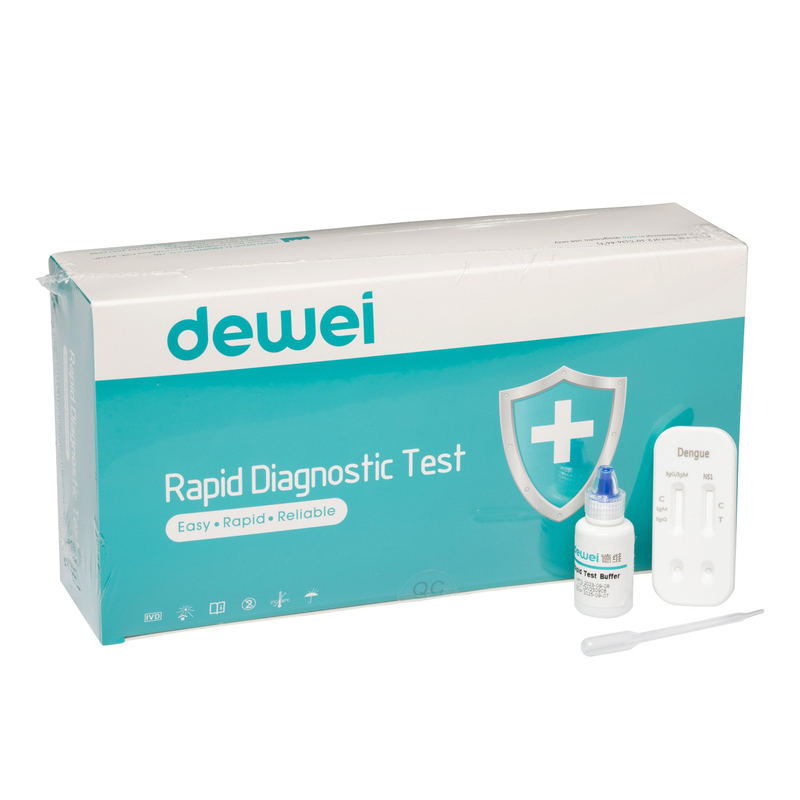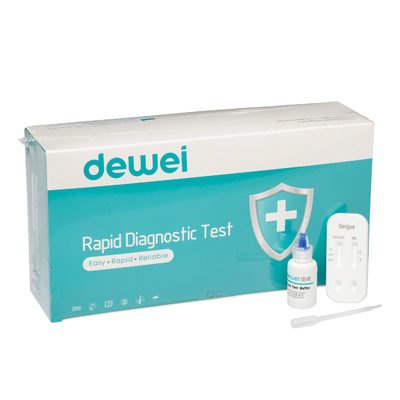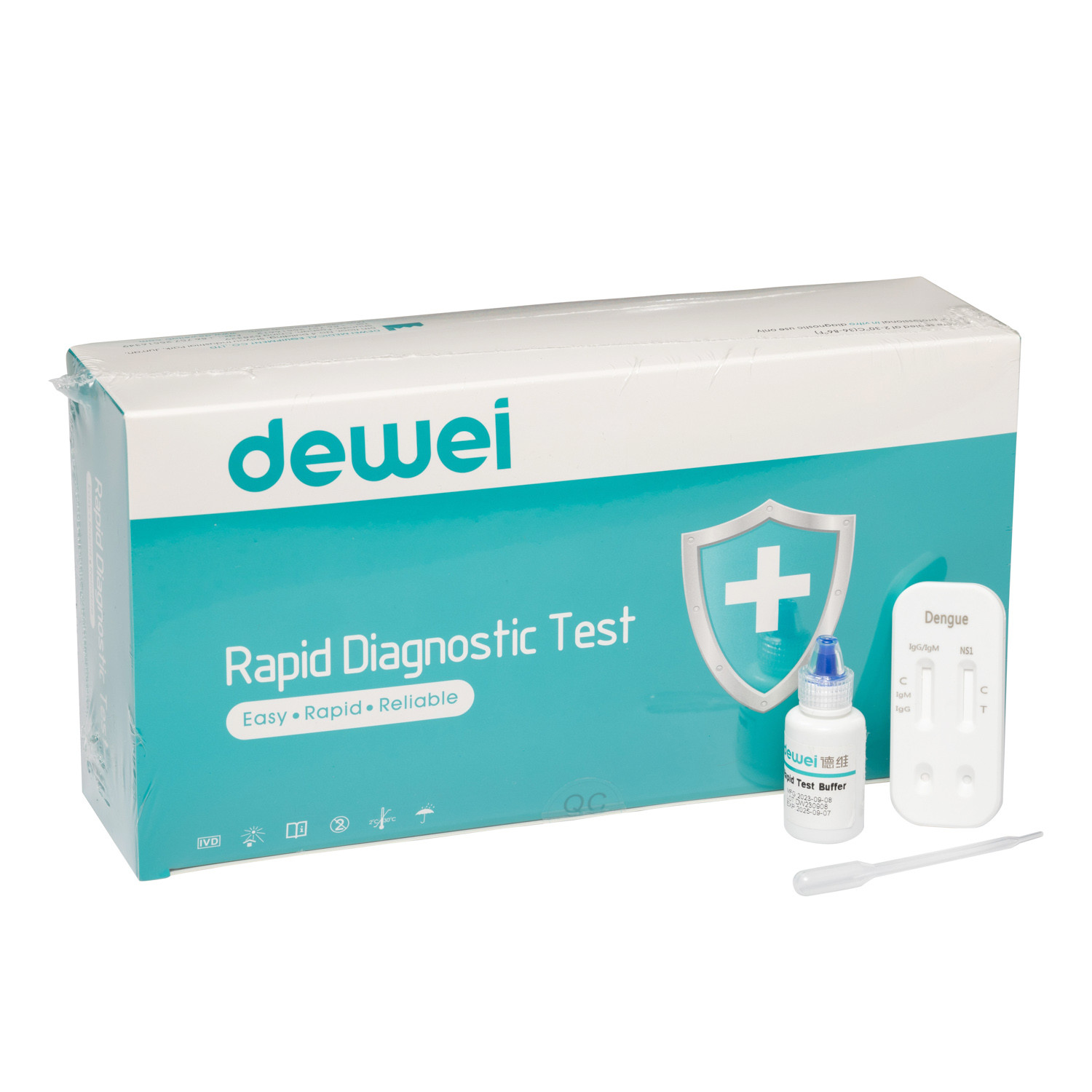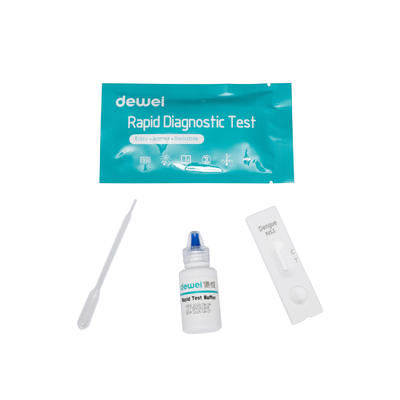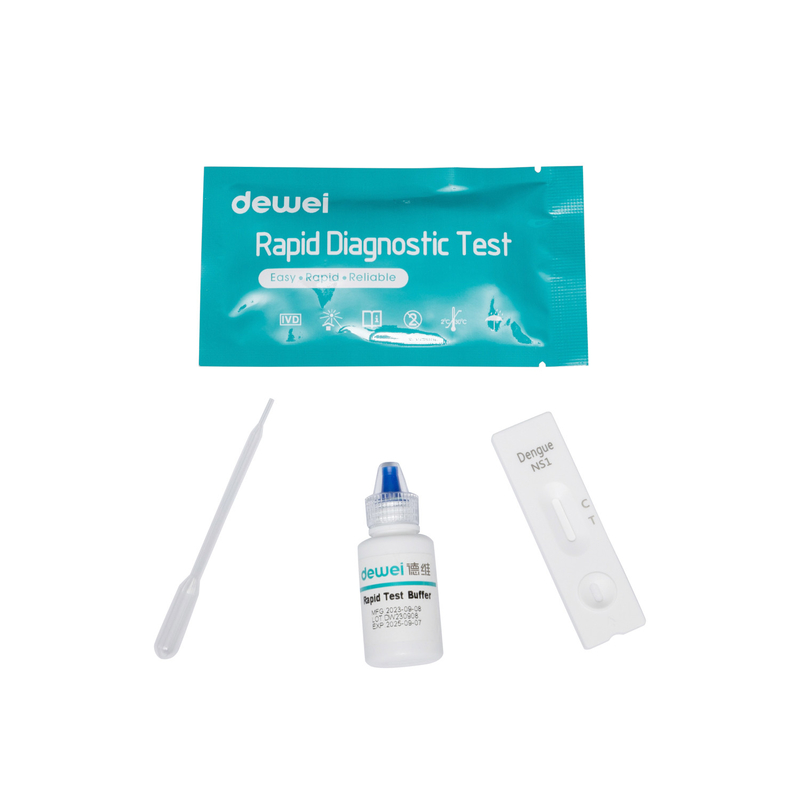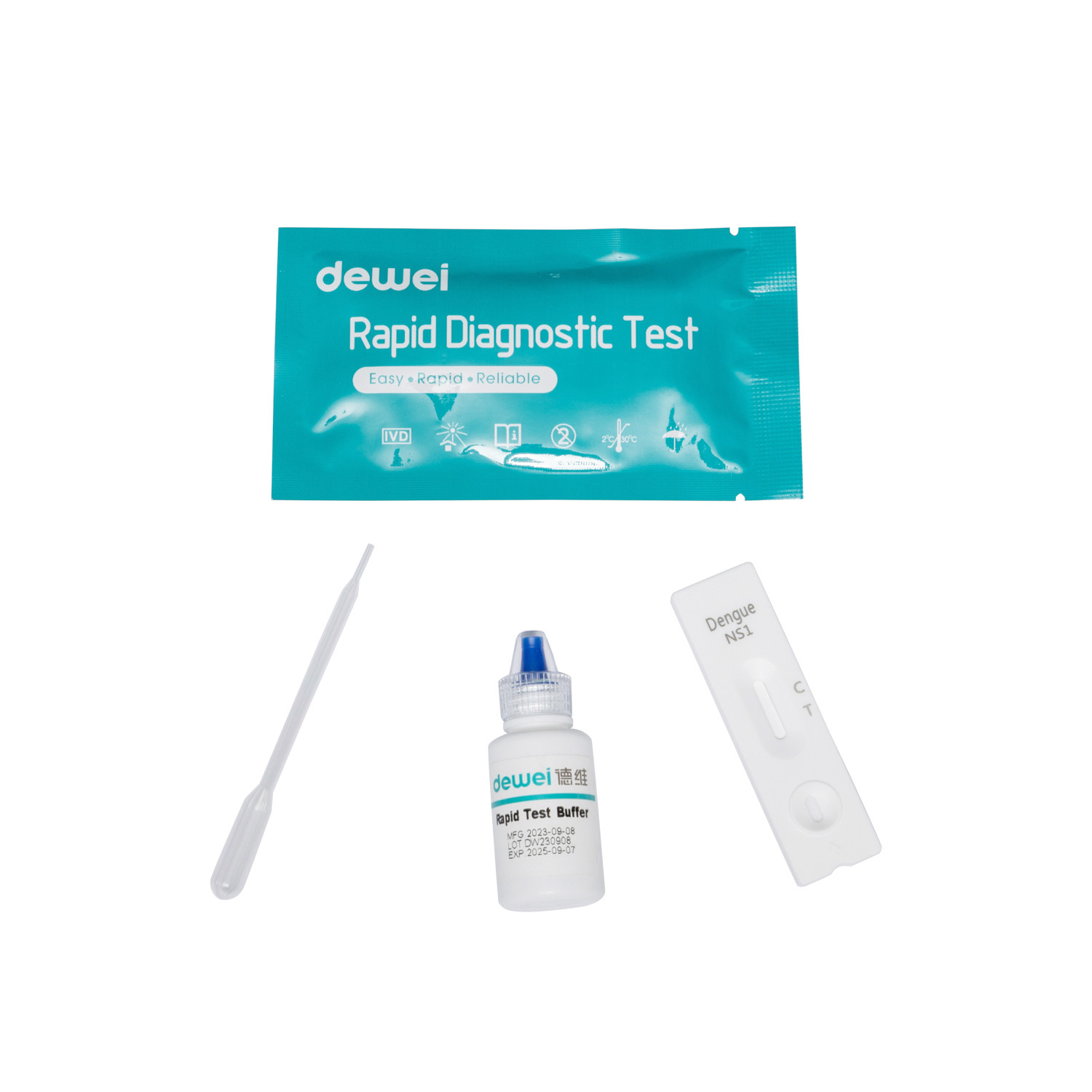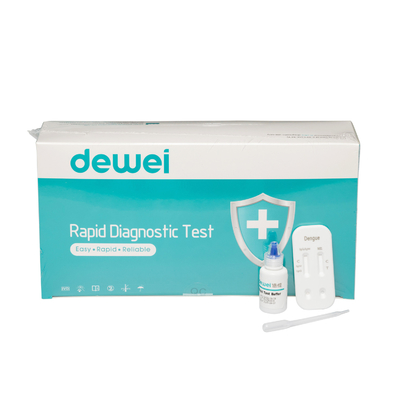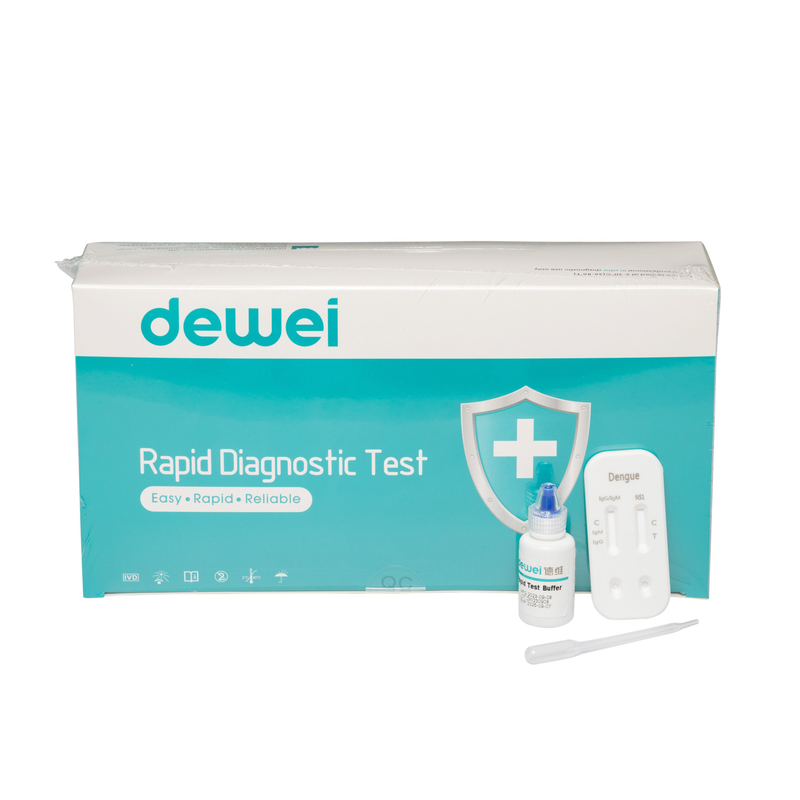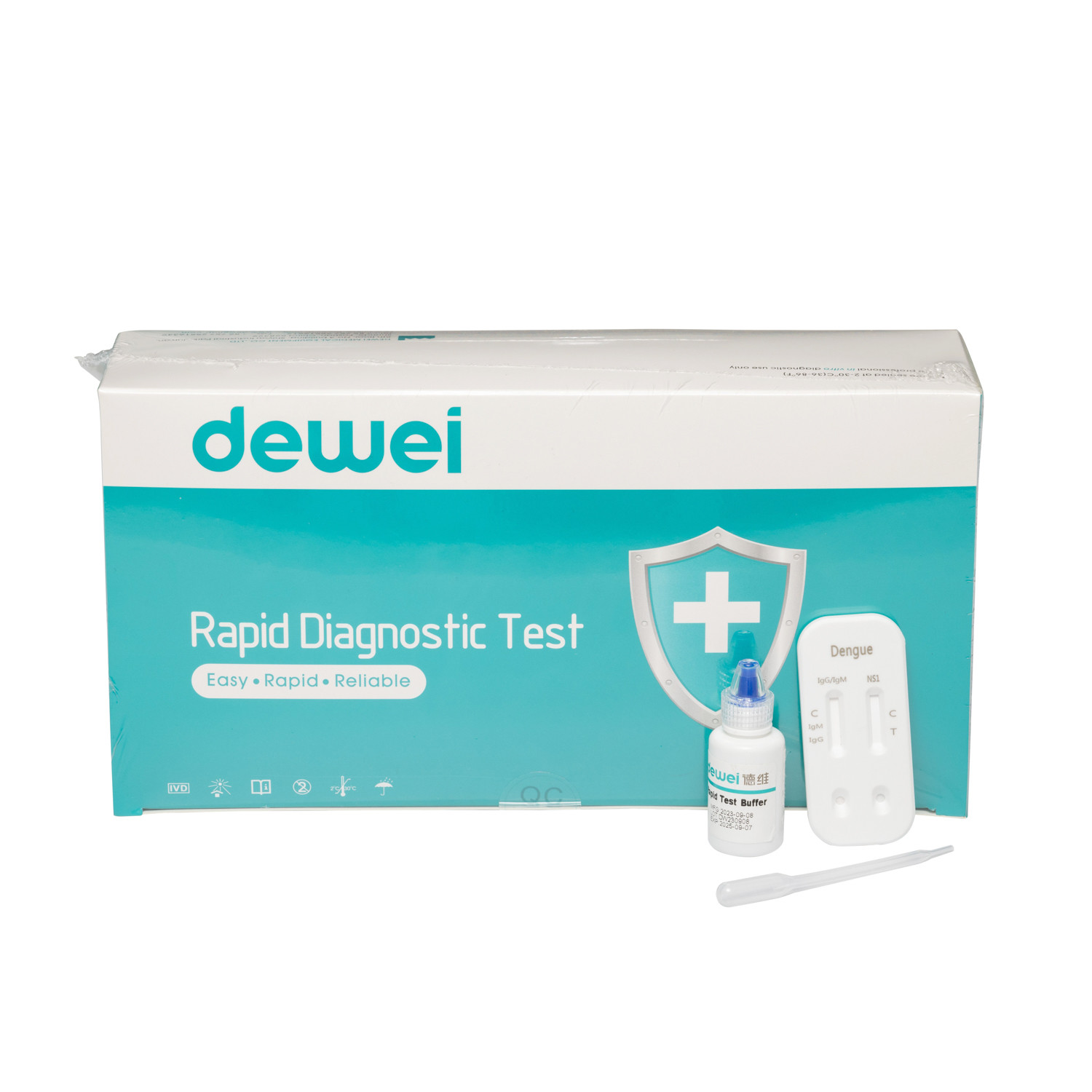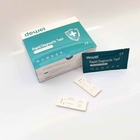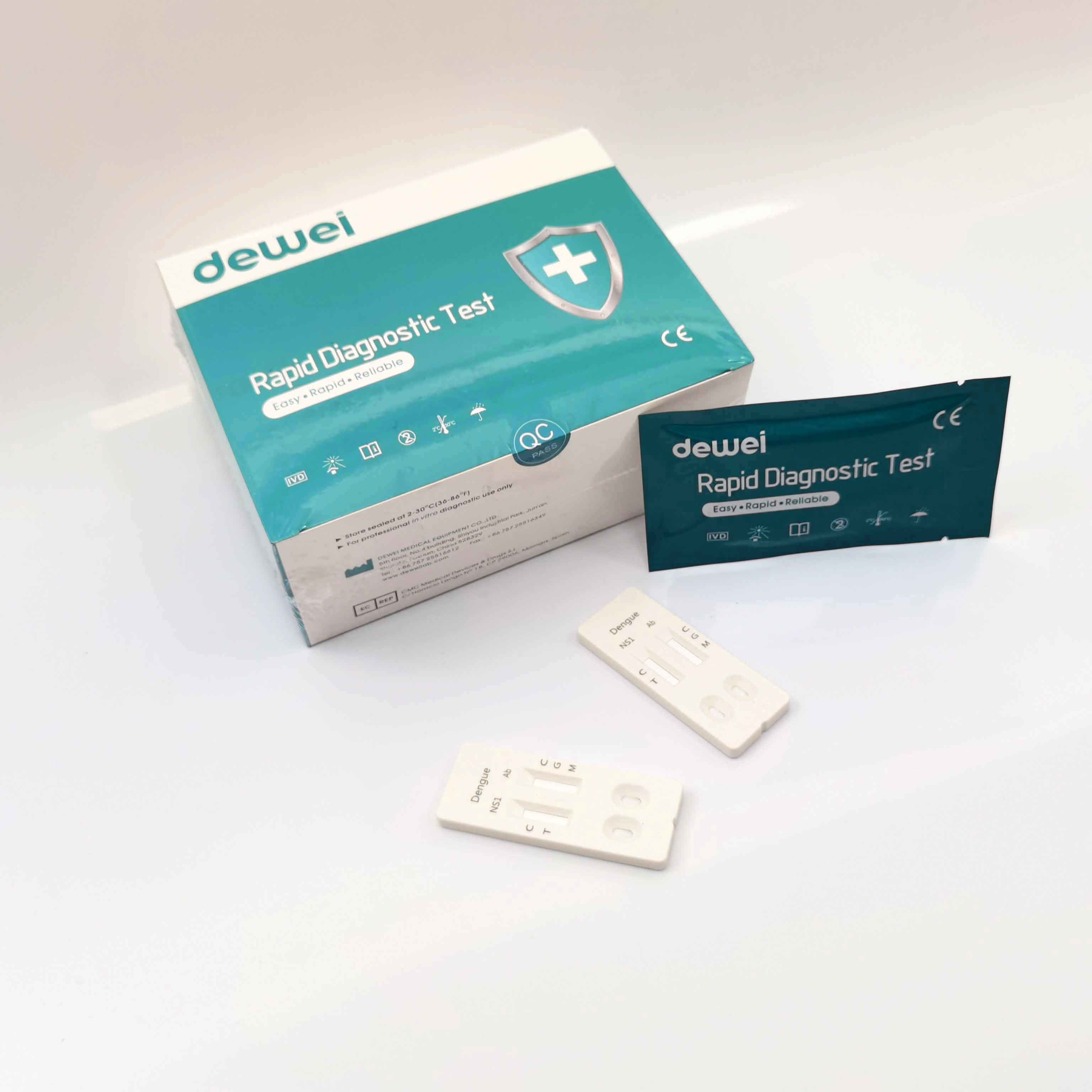Dengue Rapid Test Diagnostic Kit Antibody IgG/IgM Antigen NS1 Combo
INTENDED USE
The Dengue IgG and IgM Antibody + NS1 Antigen Test Combo (Whole Blood/Serum/Plasma) is a rapid chromatographic immunoassay for the qualitative detection of dengue virus in human whole blood, serum, or plasma as an aid in the diagnosis of primary and secondary Dengue infections.
INTRODUCTION
Dengue viruses, transmitted by the mosquito, Aedes aegypti and Aedes albopictus mosquitoes, are widely distributed throughout the tropical and subtropical areas of the world. There are four known distinct serotypes (dengue virus 1, 2, 3 and 4). In children, infection is often subclinical or causes a self-limited febrile disease. However, if the patient is infected second times with a different serotype, a more severe disease, dengue hemorrhagic fever or dengue shock syndrome, is more likely to occur.
Anitbody Dengue IgG/IgM :
Primary Dengue infection causes IgM antibodies to increase to a detectable level in 3 to 5 days after the onset of fever. IgM antibodies generally persist for 30 to 90 days.3 Most Dengue patients in endemic regions have secondary infections,4 resulting in high levels of specific IgG antibodies prior to or simultaneous with IgM response.5 Therefore, the detection of specific anti-Dengue IgM and IgG antibodies can also help to distinguish between primary and secondary infections.
Antigen Dengue NS1 :
Dengue NS1 is a highly-conserved glycoprotein that is present at high concentrations in the sera of dengue-infected patients during the early clinical phase of the disease. NS1 antigen is found from the first day and up to 9 days after onset of fever in sample of primary or secondary dengue infected patients.
PRINCIPLE
Anitbody Dengue IgG/IgM :
The Dengue IgG/IgM Rapid Test is a qualitative membrane-based immunoassay for the detection of Dengue antibodies in whole blood, serum, or plasma. This test consists of two components, an IgG component and an IgM component. In the IgG component, anti-human IgG is coated in test line region 1 of the test. During testing, the specimen reacts with Dengue antigen-coated particles in the test strip. The mixture then migrates upward on the membrane chromatographically by capillary action and reacts with the anti-human IgG in test line region 1. If the specimen contains IgG antibodies to Dengue, a colored line will appear in test line region 1. In the IgM component, anti-ligand is coated in test line region 2 of the test. During testing, the specimen reacts with ligand anti-human IgM. Dengue IgM antibodies, if present in the specimen, reacts with the ligand anti-human IgM and the Dengue antigen-coated particles in the test strip, and this complex is captured by the anti-ligand, forming a colored line in test line region 2.
Therefore, if the specimen contains Dengue IgG antibodies, a colored line will appear in test line region 1. If the specimen contains Dengue IgM antibodies, a colored line will appear in test line region 2. If the specimen does not contain Dengue antibodies, no colored line will appear in either of the test line regions, indicating a negative result. To serve as a procedural control, a colored line will always change from blue to red in the control line region, indicating that the proper volume of specimen has been added and membrane wicking has occurred.
Antigen Dengue NS1 :
The Dengue NS1 Ag Test is a qualitative membrane-based immunoassay for the detection of Dengue NS1 antigen in whole blood, serum, or plasma. During testing, the specimen reacts with anti-dengue NS1 -coated particles in the test strip. The mixture then migrates upward on the membrane chromatographically by capillary action and reacts with the anti-dengue NS1 Ag in test line region. If the specimen contains Dengue virus NS1, a colored line will appear in test line region. If the specimen does not contain Dengue virus NS1, no colored line will appear in the test line regions, indicating a negative result. To serve as a procedural control, a colored line will always in the control line region, indicating that the proper volume of specimen has been added and membrane wicking has occurred.
MAIN CONTENTS
Rapid Test Cassette in Pouch
Buffer
Disposable dropper
Package insert
STORAGE
Store as packaged in the sealed pouch at room temperature or refrigerated (2-30°C).
The test is stable through the expiration date printed on the sealed pouch.
The test must remain in the sealed pouch until use.
DO NOT FREEZE.
Do not use beyond the expiration date.
OPERATION PROCEDURE
Allow the test device, specimen, buffer, and/or controls to reach room temperature (15-30°C) prior to testing.
Antibody Dengue IgG/IgM:
1. Bring the pouch to room temperature before opening. Remove the test device from the sealed pouch and use it as soon as possible.
2. Place the test device on a clean and level surface.
For Serum or Plasma Specimens:
Hold the dropper vertically, draw the specimen up to the Fill Line (approximately 5 uL), and transfer the specimen to the specimen well (S) of the test device, then add 3 drops of buffer (approximately 90 mL) and start the timer. See illustration below. Avoid trapping air bubbles in the specimen well (S).
For Whole Blood (Venipuncture/Fingerstick) Specimens:
To use a dropper: Hold the dropper vertically, draw the specimen 0.5-1 cm above the Fill Line, and transfer 1 drop of whole blood (approximately 10 µL) to the specimen well (S) of the test device, then add 3 drops of buffer (approximately 90 uL) and start the timer. See illustration below.
To use a micropipette: Pipette and dispense 10 µL of whole blood to the specimen well (S) of the test device, then add 3 drops of buffer (approximately 90 µL) and start the timer. See illustration below.
Antigen Dengue NS1 :
1. Remove the test from its sealed pouch, and place it on a clean, level surface. Label the device with patient or control identification. For best results, the assay should be performed within one hour.
2. Transfer 3 drops of serum/plasma (approximately 75 µL) to the specimen well (S) of the device with the provided disposable pipette, and start the timer.
Allow 2 drops of whole blood (approximately 50 µL) to fall into the center of the specimen well(s) of the test device then add 1 drop of buffer, and start the timer.
Avoid trapping air bubbles in the specimen well (S), and do not add any solution to the result area.
As the test begins to work, color will migrate across the membrane.
3. Wait for the colored band(s) to appear. The result should be read at 10 minutes. Do not interpret the result after 20 minutes.
INTERPRETATION
Antibody Dengue IgG/IgM:
Antigen Dengue NS1 :
FRQ:
| 1 |
What are 7 warning signs of dengue? |
Warning Signs*
Abdominal pain or tenderness.
Persistent vomiting.
Clinical fluid accumulation.
Mucosal bleed.
Lethargy or restlessness.
Liver enlargement > 2 cm.
Laboratory finding of increasing HCT concurrent with rapid decrease in platelet count. |
| 2 |
How long will dengue fever last? |
How Long Does Dengue Fever Last? Symptoms can start anywhere from 4 days to 2 weeks after being bitten by an infected mosquito, and typically last for 2 to 7 days. |
| 3 |
What is the best treatment for dengue? |
Most cases of dengue fever can be treated at home with pain medicine. Acetaminophenparacetamol is often used to control pain. Non-steroidal anti-inflammatory drugs like ibuprofen and aspirin are avoided as they can increase the risk of bleeding. For people with severe dengue, hospitalization is often needed. |
| 4 |
Is dengue very serious? |
Severe dengue fever can cause internal bleeding and organ damage. Blood pressure can drop to dangerous levels, causing shock. In some cases, severe dengue fever can lead to death. Women who get dengue fever during pregnancy may be able to spread the virus to the baby during childbirth. |
| 5 |
How do you confirm dengue? |
If an infection is suspected, you will get a blood test to check for the dengue virus. During a blood test, a health care professional will take a blood sample from a vein in your arm, using a small needle. After the needle is inserted, a small amount of blood will be collected into a test tube or vial. |
| 6 |
What not to eat in dengue? |
It is best to choose a lighter diet and avoid oily and fried food. It contains a lot of fat which may lead to higher blood pressure. This can hamper your recovery as it weakens the immune system. |
| 7 |
What is the danger period of dengue? |
Dengue in the critical phase occurs from the 4th to the 7th day since the patient shows symptoms of fever. At this time, the patient may not have a fever or reduce his fever, so he will appear subjective and do not go to the hospital for treatment, making the disease more dangerous. |
| 8 |
Can dengue recover by itself? |
Dengue fever usually lasts between 2 to 7 days.
Most people recover from dengue infection without requiring hospital admission. |
| 9 |
What kills dengue virus? |
To fight the infection, the immune system produces antibodies to neutralize the dengue viral particles, and the complement system is activated to help the antibodies and white blood cells remove the virus. The immune response also includes cytotoxic T cells (lymphocytes), which recognize and kill infected cells. |
| 10 |
Which antibiotic is best for dengue? |
There is no specific medicine to treat dengue infection. If you think you may have dengue fever, you should use pain relievers withacetaminophen and avoid medicines with aspirin, which could worsen bleeding. You should also rest, drink plenty of fluids, and see your doctor. |
| 11 |
How to recover fast from dengue? |
Turmeric with milk is best remedy for faster recovery. Citrus fruits play an important role for dengue patients and it help in recovery. So, rich mix of antioxidants and vitamin C like orange, strawberries, lemon, papaya etc should be included in a diet twice a day," says Dr Sharma. |
| 12 |
Is a CBC test for dengue? |
Complete Blood Count (CBC): The complete blood count test is employed to assess various components of the blood. One crucial aspect is the platelet count, which tends to decrease during the later stages of dengue fever. Monitoring platelet levels is essential as low platelet count can lead to bleeding complications. |
| 13 |
How many days do platelets fall in dengue? |
Platelet counts usually drop significantly by day 4 of illness. In adults without dengue shock, platelet counts drop slightly to moderate from day 3 to day 7 of illness and return to normal by day 8 or 9. |
| 14 |
What is the recovery stage of dengue? |
The recovery phase is the final stage of dengue fever. Individuals who have passed the febrile phase without entering the critical phase, or those who have recovered from the critical second phase for 1-2 days, will reach the recovery phase. |
| 15 |
Can I test dengue at home? |
These tests look for the NS1 protein from the dengue virus in the blood. They usually use special antibodies with labels to find this protein. Orange Health Labs offers the convenience of dengue fever NS1 Antigen Rapid Test at home anywhere in Bangalore. |
| 16 |
Can I drink milk in dengue? |
You can drink more milk to enhance nutrition. Do not eat rice or hard foods that require a lot of chewing and are difficult to swallow. Especially, for children with dengue fever, milk is the main and most important source of nutrition. |
| 17 |
What to not eat in dengue? |
Dengue patients must exclude raw & strongly flavored veggies from their diet, such as cabbage, capsicum, turnip, radish, onion, garlic, eggplant, etc.
|
For details, please contact Dewei staff for Instruction Manual!



 Your message must be between 20-3,000 characters!
Your message must be between 20-3,000 characters! Please check your E-mail!
Please check your E-mail!  Your message must be between 20-3,000 characters!
Your message must be between 20-3,000 characters! Please check your E-mail!
Please check your E-mail! 

